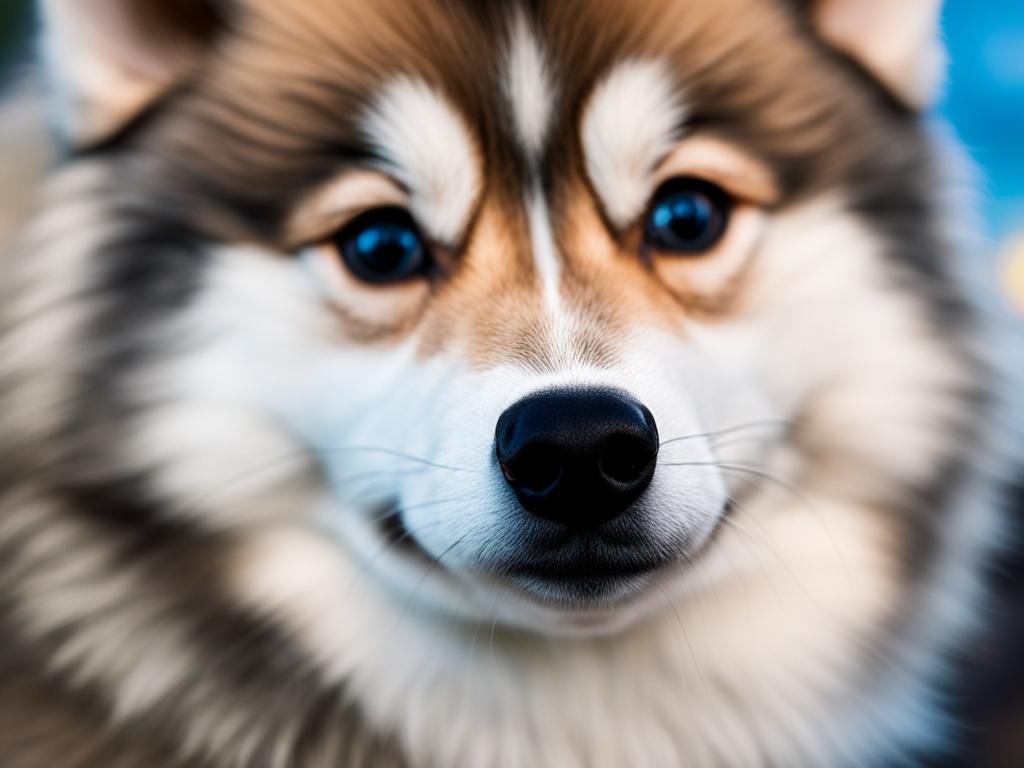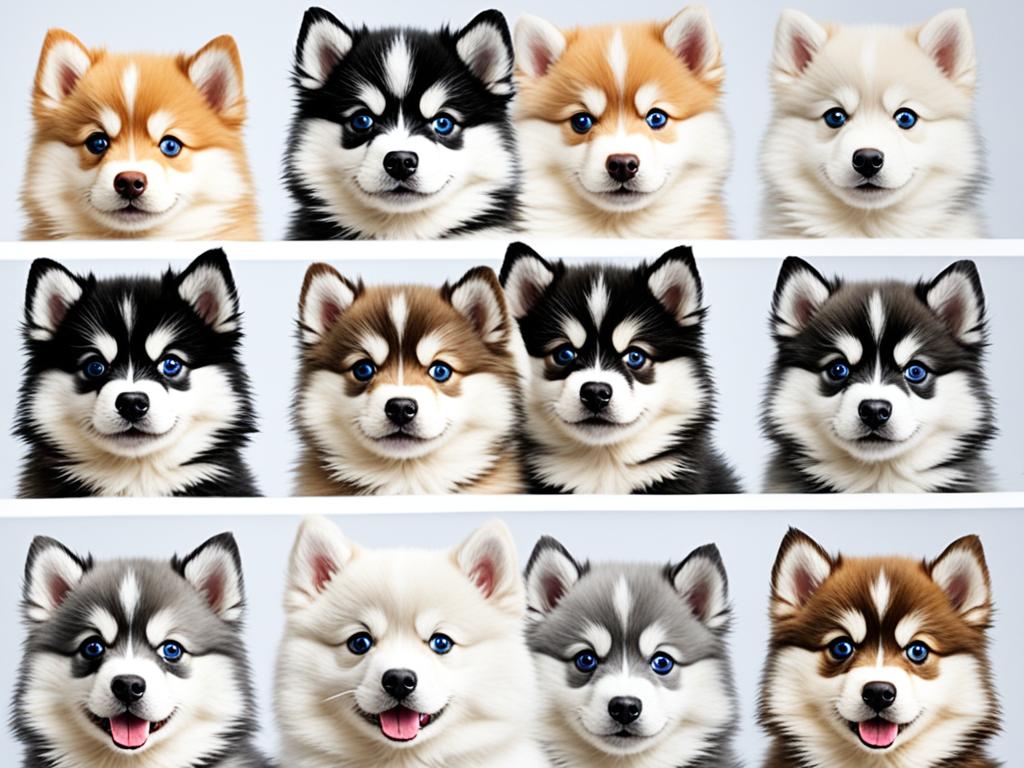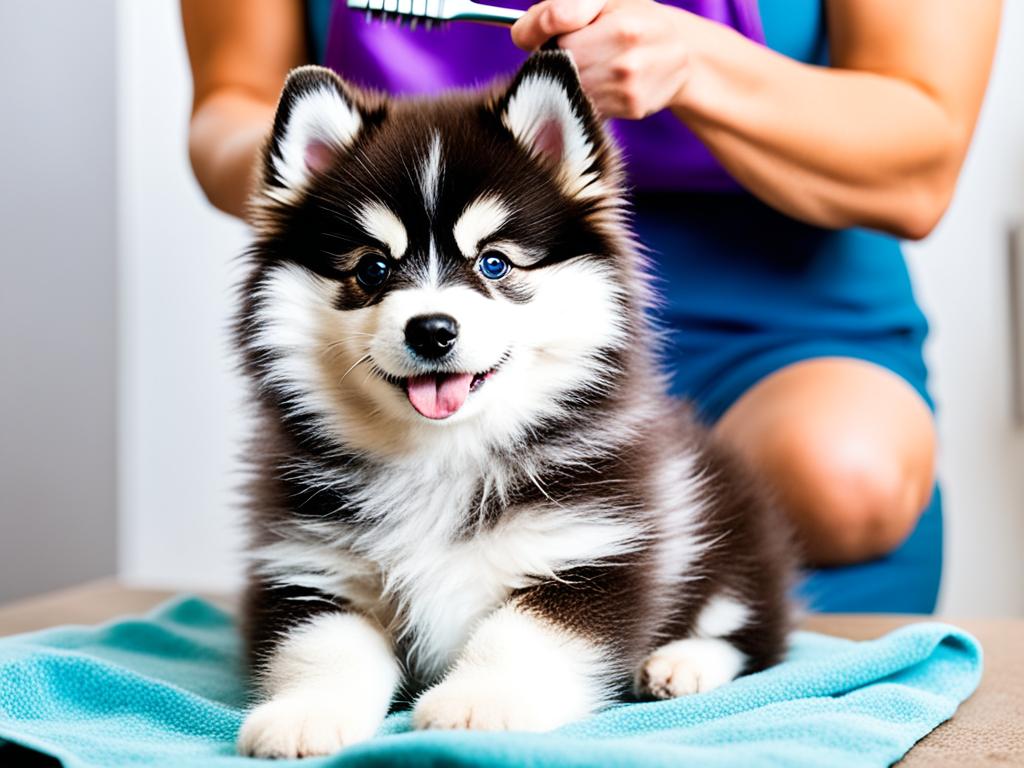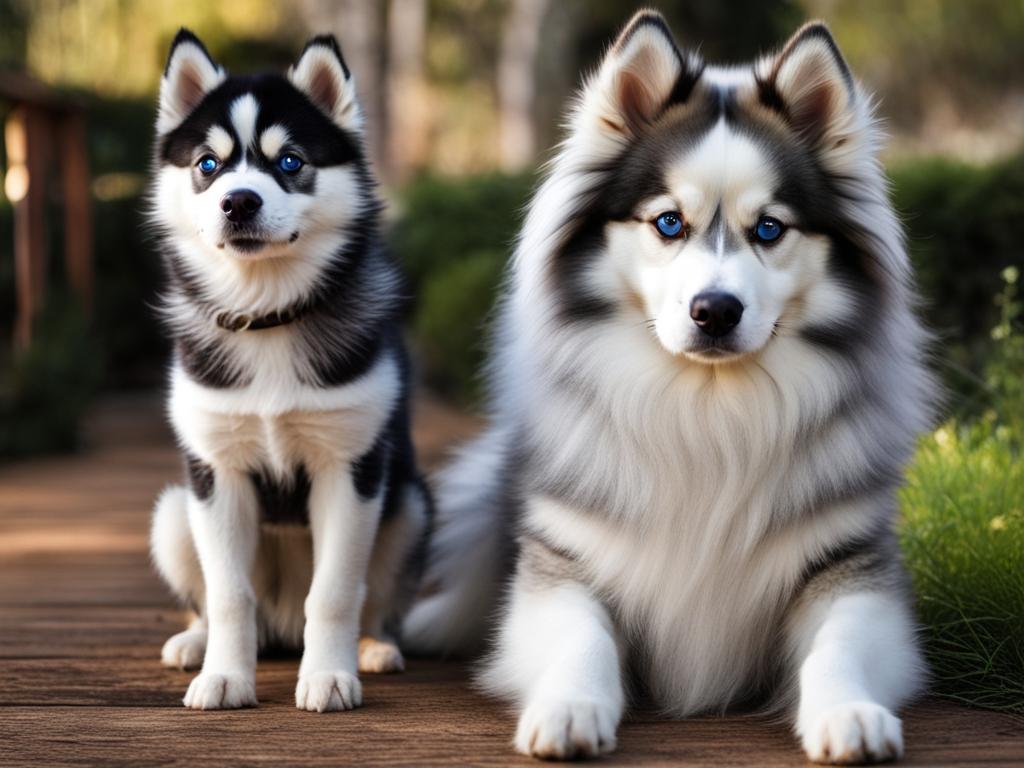The Origins of the Pomsky Mix: The Parents
The Pomsky is a unique crossbreed between a Siberian Husky and a Pomeranian, created through artificial insemination. This deliberate breeding method enables these two distinct breeds to produce offspring with a desirable mix of traits.
The Pomsky’s origins can be traced back to the early 2000s when breeders began experimenting with crossing Siberian Huskies and Pomeranians to create a smaller, more manageable version of the Siberian Husky. The intention was to combine the Husky’s striking appearance with the Pomeranian’s compact size.
Siberian Husky
The Siberian Husky is a majestic and highly energetic breed that originated in northeastern Russia. They were bred by the Chukchi people for sled pulling and endurance in harsh Arctic conditions. Siberian Huskies are known for their strong work ethic, endurance, and beautiful coat. With their striking blue or multi-colored eyes and captivating demeanor, they make for a visually stunning breed.
Pomeranian
The Pomeranian is a tiny dog breed that originated in the Pomerania region of Germany and Poland. Despite their small size, Pomeranians have a big personality. They are known for being alert, intelligent, and highly social dogs. Their fluffy double coat and plumed tail give them a distinctive appearance.
The crossbreeding of these two breeds—the Siberian Husky and the Pomeranian—resulted in the creation of the Pomsky. This designer breed exhibits a wide range of appearances, sizes, temperaments, and behaviors based on the traits inherited from its parent breeds.
Controversy Surrounding the Pomsky
The rising popularity of Pomskies has not come without controversy. Some critics argue that designer breeds, including the Pomsky, contribute to irresponsible breeding practices and the rise of puppy mills. They express concerns about the ethics and welfare of the dogs involved.
It is essential for prospective Pomsky owners to research reputable breeders who prioritize the health and well-being of their dogs. Responsible breeders adhere to ethical breeding practices and prioritize the health, temperament, and quality of their puppies.
Furthermore, it is important for potential owners to understand that the Pomsky is a relatively new and evolving breed. As such, there may still be uncertainties regarding breed standards and consistency in characteristics across individual Pomskies.
The Siberian Husky
The Siberian Husky is an athletic and intelligent medium-sized breed. With their striking appearance, thick double coat, and captivating blue eyes, Huskies are undeniably eye-catching. They require both mental and physical stimulation to prevent boredom and destructive behavior, making them a great choice for active individuals or families.
Here are some key characteristics of Siberian Huskies:
- Adventurous: Huskies have a strong sense of adventure and love exploring their surroundings. They enjoy outdoor activities like hiking, running, or playing fetch.
- Independent: Huskies have an independent nature and are known for their stubbornness. This can sometimes make training a bit challenging, especially for first-time dog owners.
- Sociable: Siberian Huskies are generally friendly and sociable dogs. They thrive on human companionship and enjoy being part of a pack. Proper socialization from an early age is important to ensure they interact well with other dogs and people.
- Talkative: Huskies are known for their talkative nature. They often vocalize their feelings through howls, barks, and even “talking” noises. This can be quite entertaining but may not be suitable for those who prefer a quieter breed.
Husky Care Tips
To keep your Siberian Husky healthy and happy, consider these care tips:
- Grooming: Huskies have a thick double coat that requires regular brushing to prevent matting and shedding. Additionally, they may shed heavily twice a year during shedding seasons.
- Exercise: Huskies have high energy levels and require regular exercise to keep them physically and mentally stimulated. Daily walks, jogs, or playtime in a securely fenced yard are essential.
- Mental Stimulation: Huskies are intelligent dogs that need mental stimulation to prevent boredom. Puzzle toys, interactive games, and obedience training can help keep their minds active.
- Temperature: Huskies have a thick coat that provides insulation in cold weather. However, they can overheat easily in warm climates. Ensure they have access to shade and fresh water during hot days.
- Healthcare: Regular veterinary check-ups, vaccinations, and preventive treatments are essential for maintaining the health and well-being of your Husky. They can be prone to certain health issues, including hip dysplasia, eye problems, and skin allergies.
The Siberian Husky’s unique characteristics, coupled with their stunning appearance, make them a beloved breed among dog enthusiasts. With proper care, training, and socialization, your Husky can bring joy and adventure to your life.
The Pomeranian
The Pomeranian is a small and fluffy breed known for its spunky and energetic personality. They have a big brain for their tiny body and require mental stimulation to prevent bad habits. Pomeranians are quick learners and can be easily trained. They make great lap dogs and enjoy being spoiled with attention and affection. Despite their small size, they can be territorial and may exhibit defensive barking.
Pomeranian Characteristics
Let’s take a closer look at the characteristics that make the Pomeranian breed unique:
| Characteristics | Description |
|---|---|
| Size | Small and compact, typically weighing between 3 to 7 pounds. |
| Coat | Double coat with a fluffy and dense undercoat, and a longer, straight or wavy outer coat. |
| Appearance | Distinct fox-like face, fluffy plumed tail, and erect ears. |
| Temperament | Lively, alert, and courageous; can be friendly and outgoing with proper socialization. |
Pomeranian Behavior
Understanding the behavior of Pomeranians is essential for effective care and training:
- Attention seekers: Pomeranians love being in the spotlight and enjoy being the center of attention.
- Playful: They have a playful nature and require regular exercise and mental stimulation.
- Protective: Pomeranians can be protective of their family, which may manifest as territorial behavior and defensive barking.
- Quick learners: With their high intelligence, Pomeranians respond well to training and can learn various commands and tricks.
Pomeranian Care
Proper care is essential to ensure the health and well-being of your Pomeranian:
- Grooming: Regular brushing to prevent matting and tangles, along with occasional bathing and nail trimming.
- Dental care: Regular teeth brushing and dental check-ups to maintain oral hygiene.
- Exercise: Daily walks and playtime to fulfill their exercise needs and prevent obesity.
- Socialization: Early socialization with other dogs, animals, and people to ensure proper behavior and reduce the likelihood of aggression.
By providing appropriate care, understanding their behavior, and addressing their needs, you can create a happy and healthy environment for your beloved Pomeranian.
The Appearance of the Pomsky
Pomskies, as first-generation designer breeds, can exhibit a wide range of appearances. They often resemble mini Siberian Huskies, showcasing characteristics such as marbled coat patterns and large ears. The coat of a Pomsky can vary in length, texture, and color, resulting in unique variations among individuals.
Here are some key aspects of the Pomsky’s appearance:
- Coat: The Pomsky’s coat can come in different lengths, ranging from short to long. Some Pomskies have a dense, double-layered coat like their Husky parent, while others have a single-layered coat inherited from the Pomeranian. Regular grooming and brushing are necessary to keep their coat healthy and reduce shedding.
- Color: Pomskies can display various coat colors, including combinations of black, grey, white, and red. Each Pomsky’s coat color can be unique, showcasing different patterns and shades.
- Size: Pomskies are typically smaller in size than Siberian Huskies but larger than most Pomeranians. Their size can vary depending on the parent breeds, with an average height of 10 to 15 inches and weight ranging from 10 to 35 pounds.
Here is an image representing the beautiful coat variations of Pomskies:

As shown in the image, Pomskies can exhibit a wide range of coat colors and patterns, making each one unique.
It’s important to remember that the appearance of a Pomsky can differ significantly from one dog to another, depending on the traits inherited from the parent breeds. If you have specific preferences for a certain coat color or pattern, it is advisable to consult with a reputable breeder who can provide more information about the potential outcomes.
The Temperament of the Pomsky
The Pomsky is a relatively new breed, and as such, their temperament can vary from dog to dog. However, there are some general characteristics that can typically be seen in Pomskies.
Intelligent: Pomskies are known for their intelligence. They are quick learners and can pick up new commands and tricks with ease.
Affectionate: Pomskies are affectionate dogs that form strong bonds with their owners. They enjoy being close to their family members and thrive on attention and love.
Social: Proper socialization is crucial for Pomskies. They need to be exposed to different people, animals, and environments from a young age to ensure they grow up to be well-rounded and friendly dogs.
Attention-seeking: Pomskies have a natural tendency to seek attention. They may exhibit behaviors like barking, jumping, or pawing to get the attention they crave.
Given their intelligence and craving for attention, it is essential to provide Pomskies with proper training and socialization.
Socialization:
Socializing a Pomsky from an early age is vital to ensure they develop good behavior and can interact well with other dogs and people. Socialization should include exposure to various environments, sounds, smells, and situations. It helps them become confident, well-behaved, and less prone to anxiety or fear-based behaviors.
Training:
Training is an essential part of raising a Pomsky. It helps establish boundaries, teaches them proper behavior, and prevents common issues such as excessive barking or destructive chewing. Positive reinforcement methods, such as rewards and treats, work best with Pomskies as they respond well to praise and motivation.
A well-trained Pomsky is a happy Pomsky, and investing time and effort into training will result in a better-behaved and more enjoyable companion.
| Key Traits | Description |
|---|---|
| Intelligent | Pomskies are quick learners and can pick up commands and tricks easily. |
| Affectionate | They form strong bonds with their owners and enjoy being close to them. |
| Social | Proper socialization is crucial for Pomskies to ensure they are friendly and well-behaved around other dogs and people. |
| Attention-seeking | Pomskies naturally seek attention and may exhibit attention-seeking behaviors to get it. |
The Statistical Lowdown on the Pomsky
When considering a Pomsky as your furry companion, it’s important to have a clear understanding of their statistics and physical characteristics. Let’s delve into the key details regarding the Pomsky’s lifespan, weight, height, coat, and colors.
Pomsky Lifespan
The average lifespan of a Pomsky is typically between 12 to 16 years, which is similar to their parent breeds, the Siberian Husky and the Pomeranian. Providing them with proper care, nutrition, exercise, and regular veterinary check-ups can contribute to their overall well-being and longevity.
Pomsky Weight and Height
Pomskies vary in size, weighing anywhere from 10 to 35 pounds. Their height typically ranges from 10 to 15 inches at the shoulder. The specific weight and height of an individual Pomsky can depend on factors such as genetics and the specific mix of Husky and Pomeranian traits.
Pomsky Coat
The Pomsky’s coat is known for its density and may require regular brushing to manage shedding. The length and texture of the coat can vary, with some Pomskies having a shorter and smoother coat, while others may have a longer and fluffier coat. Regular grooming helps maintain their coat’s health and appearance.
Pomsky Colors
Pomskies come in a variety of colors, ranging from white with black, grey, or reddish-brown markings. These beautiful color variations add to the uniqueness and charm of each Pomsky. The specific colors and patterns a Pomsky inherits can vary based on their individual genetic makeup.

Understanding the statistical aspects of a Pomsky’s lifespan, weight, height, coat, and colors is essential to make an informed decision when considering this delightful breed as a part of your family. Keep in mind that individual Pomskies may showcase variations within these statistics, reflecting their own unique genetic composition and characteristics.
Caring for a Pomsky Puppy
Caring for a Pomsky puppy involves several crucial aspects. By providing proper care and attention, you can ensure that your Pomsky grows up to be a healthy and happy adult.
Socialization
One of the key factors in raising a well-behaved Pomsky is socialization. Introduce your puppy to various environments, people, and animals from a young age. This will help them develop into friendly and confident adults. Organize playdates with other dogs and enroll in obedience classes to expose your Pomsky to new experiences and ensure they learn social skills.
Grooming
Pomskies have a thick and often double coat that requires regular grooming to keep it healthy and looking its best. Brush your Pomsky’s coat at least once a week to prevent mats and remove loose hair. Additionally, clean their ears regularly to prevent infections.

Diet
A nutritious diet is essential for the overall health of your Pomsky puppy. Choose a high-quality dog food that meets their specific dietary needs. Consult with your veterinarian to determine the appropriate portion sizes and feeding schedule for your Pomsky. Avoid overfeeding to prevent obesity, as excess weight can lead to various health problems.
Exercise
Pomskies are energetic dogs that require regular exercise to stay physically and mentally stimulated. Engage them in daily activities such as walks, playtime, and interactive games. Keeping your Pomsky active will help prevent behavioral issues caused by boredom and ensure their well-being.
Remember to consult with your veterinarian for specific recommendations on diet, exercise, and general care based on the individual needs of your Pomsky puppy. With proper care and attention, your Pomsky will grow into a happy and healthy companion.
Training a Pomsky
Training is an essential aspect of raising a Pomsky. These intelligent dogs can quickly learn new commands and behaviors with the right approach. Using positive reinforcement methods and consistency is key to their success. Basic obedience training is crucial for their safety and well-being.
Pomskies may have a stubborn streak, so it’s important to use positive and reward-based training techniques. Patience and persistence are necessary to overcome any challenges during the training process. Teaching commands like sit, stay, and come are fundamental to establish good behavior in your Pomsky.
Recommended Pomsky Commands:
- Sit: Teach your Pomsky to sit on command, which is useful in various situations, such as during mealtime or when meeting new people.
- Stay: Train your Pomsky to stay in one place until given the release command, ensuring their safety in potentially dangerous situations.
- Come: Teaching your Pomsky to come when called is crucial for their safety and allows for more off-leash freedom in appropriate environments.
- Leave It: This command helps prevent your Pomsky from picking up or engaging with anything potentially harmful or undesirable.
- Drop It: Teach your Pomsky to release items they have picked up, promoting safety and preventing destruction of property.
Consistency and practice are key to successful training. Reinforce positive behaviors with praise, treats, and affection. It’s also beneficial to socialize your Pomsky early on to ensure they interact well with other dogs and people. Professional training classes or working with an experienced trainer can provide additional guidance and support for both you and your Pomsky.

Pomsky Health Considerations
When it comes to Pomskies, like any other breed, there are certain health issues that owners should be aware of. It’s important to take proactive measures to ensure the well-being of your furry companion. Here are some key health considerations for Pomskies:
Dental Care
Pomskies are prone to dental problems, such as plaque buildup, gum disease, and tooth decay. To maintain their oral health, regular dental care is essential. This includes brushing their teeth regularly with a dog-friendly toothpaste and providing dental chews or toys to help clean their teeth.
Joint Health
Pomskies can be susceptible to joint and bone disorders, including hip dysplasia and patellar luxation. These conditions can cause pain and mobility issues. To promote good joint health, it’s important to provide a balanced diet rich in nutrients like glucosamine and chondroitin. Regular exercise that is appropriate for their size and age can also help keep their joints strong and prevent problems.
Eye Care
Pomskies may inherit certain eye problems from their parent breeds, such as progressive retinal atrophy or cataracts. Regular eye examinations by a veterinarian are crucial to identify any potential issues early on. Additionally, keeping their eye area clean and free of debris can help prevent irritation or infection.
Allergies and Respiratory Issues
Some Pomskies may develop allergies or respiratory issues, such as asthma or tracheal collapse. It’s important to be aware of the signs of respiratory distress, which may include coughing, wheezing, or difficulty breathing. If you notice any concerning symptoms, it’s best to consult with a veterinarian for proper diagnosis and treatment.
Regular check-ups with a veterinarian are essential to monitor your Pomsky’s overall health and address any potential issues promptly. This includes vaccinations, parasite prevention, and routine examinations to ensure your furry friend stays happy and healthy.
Considerations for Owning a Teacup Pomsky
Teacup Pomskies are a miniature version of the Pomsky breed, selectively bred for their smaller size. However, it’s crucial to be aware of the ethical concerns associated with breeding for extremely small sizes. While Teacup Pomskies can be adorable, their small stature can pose health risks.
Teacup dogs, including Teacup Pomskies, are more susceptible to various health issues due to their size. These risks may include fragile bones, dental problems, respiratory issues, and a higher risk of injury. It’s important for prospective owners to carefully consider these potential health risks before deciding to bring a Teacup Pomsky into their home.
Responsible breeding practices play a vital role in ensuring the well-being of Teacup Pomskies. Ethical breeders prioritize the health and welfare of their dogs over size and appearance. They conduct health screenings, provide appropriate veterinary care, and maintain high standards of breeding to minimize health risks.
Owners of Teacup Pomskies should be committed to providing proper care and regular veterinary check-ups. Ensuring a balanced diet, maintaining dental hygiene, and avoiding activities that could lead to injuries are essential. By adopting a responsible approach to caring for Teacup Pomskies, owners can contribute to their overall health and well-being.
FAQ
What is a Pomsky?
A Pomsky is a designer breed that is a cross between a Siberian Husky and a Pomeranian. They are known for their playful nature, adorable appearance, and intelligence.
How are Pomskies bred?
Pomskies are created through artificial insemination, as it allows the two vastly different breeds to produce offspring and ensures the success of the breeding process.
What are the characteristics of a Siberian Husky?
Siberian Huskies are medium-sized, athletic, and intelligent dogs. They have a striking appearance with a thick double coat and captivating blue eyes. They require mental and physical stimulation and thrive in an active lifestyle.
What are the characteristics of a Pomeranian?
Pomeranians are small, fluffy, and energetic dogs. They have a spunky personality and require mental stimulation. They are quick learners and make great lap dogs.
What does a Pomsky look like?
Pomskies can have diverse appearances, often resembling mini Siberian Huskies with marbled coat patterns and large ears. Their coat can vary in length, texture, and color, including black, grey, white, and red.
What is the temperament of a Pomsky?
Pomskies are generally known to be intelligent, affectionate, and social dogs. They require proper socialization from a young age and training to establish good behavior.
What is the average lifespan of a Pomsky?
Pomskies have an average lifespan of 12-16 years. The individual dog’s lifespan may vary depending on genetic factors and overall health.
How should I care for a Pomsky puppy?
Caring for a Pomsky puppy involves proper socialization, regular grooming, a nutritious diet, and regular exercise. Consulting with a veterinarian is essential for specific dietary and exercise recommendations.
How should I train a Pomsky?
Training a Pomsky requires patience, consistency, and positive reinforcement methods. Basic obedience training is essential for their safety and well-being.
What health issues are common in Pomskies?
Pomskies can be prone to dental problems, joint and bone disorders, eye problems, allergies, and respiratory issues. Regular dental care, a balanced diet, and regular check-ups with a veterinarian are important for their overall health.
What should I know about Teacup Pomskies?
Teacup Pomskies are bred selectively for their smaller size, but ethical concerns and potential health risks should be carefully considered. Responsible breeding practices and routine veterinary care are crucial for the well-being of Teacup Pomskies.

Leave a Reply